 An official website of the United States government. Here's how you know.
An official website of the United States government. Here's how you know.
 An official website of the United States government. Here's how you know.
An official website of the United States government. Here's how you know.  An official website of the United States government. Here's how you know.
An official website of the United States government. Here's how you know. Unit:
27th Infantry Division, 165th Infantry Regiment
Date of Birth:
January 29, 2019
Hometown:
Greeley, Colorado and Como, Wyoming
Date of Death:
July 11, 1944
Place of Death:
Mariana Islands, Saipan
Awards:
Bronze Star, Purple Heart
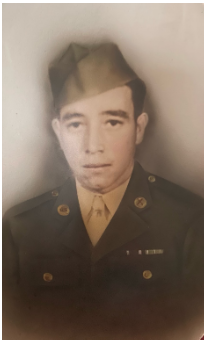
Lawrence Contreras was born on January 29, 1919, in Como, Wyoming, to Eufelia and Alfonso Contreras. Before Lawrence turned six years old, the family moved to Greeley, Colorado and began working as farm hands on a local sugar beet farm owned by the Honstein family. Due to the Great Depression, Weld County’s rich agricultural value attracted Hispanic workers. While Lawrence did not complete his elementary education, he became a productive member of the family, working side-by-side with his father on the beet farm.
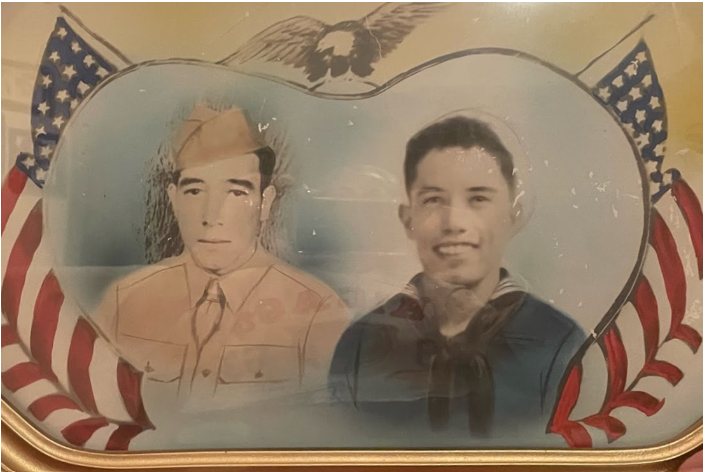
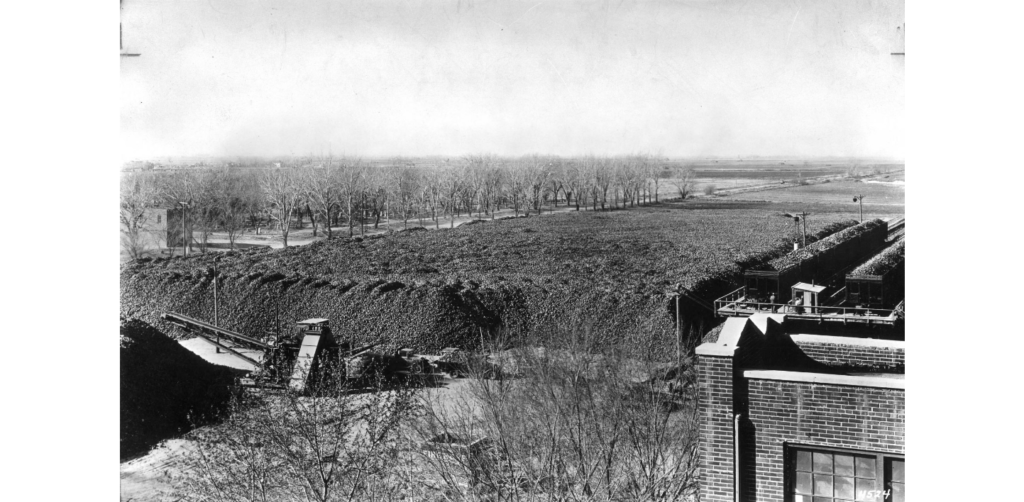
Growing up in Greeley, Colorado was not easy for Hispanic families. From the 1920s through the 1940s, they faced violence from the KKK, who hated Catholics and immigrants. This led to the building of Our Lady of Peace Catholic Church to provide a welcoming environment that afforded Hispanic families a community where language and culture were accessible to everyone.
Since the late nineteenth century, Weld County, Colorado has been a leader in agricultural production, growing corn, sugar beets, and potatoes shipped nationally to families across the United States. Because of Weld county’s agricultural productivity, Mexican immigrants were attracted to the area, realizing they could make a living wage even during the Great Depression of the late 1930s. Working side-by-side with struggling farm owners, Mexican families employed their children to help with fieldwork. Lawrence Contreras was one of those farmhands. Working alongside his parents, they battled the Dust Bowl of 1930, the Great Depression from 1929 to 1939, and a terrible water drought in 1933 due to a court decision to deny Colorado water from the North Platte River, the major water source into Greeley.
By the start of World War II, the federal government asked Colorado farmers to increase the production of cows, sheep, and pigs because eggs, milk, and meat were needed to feed the growing population of the United States. Grain production of wheat, barley, and corn also increased, but little of the crop yield went to the civilian population of Colorado.
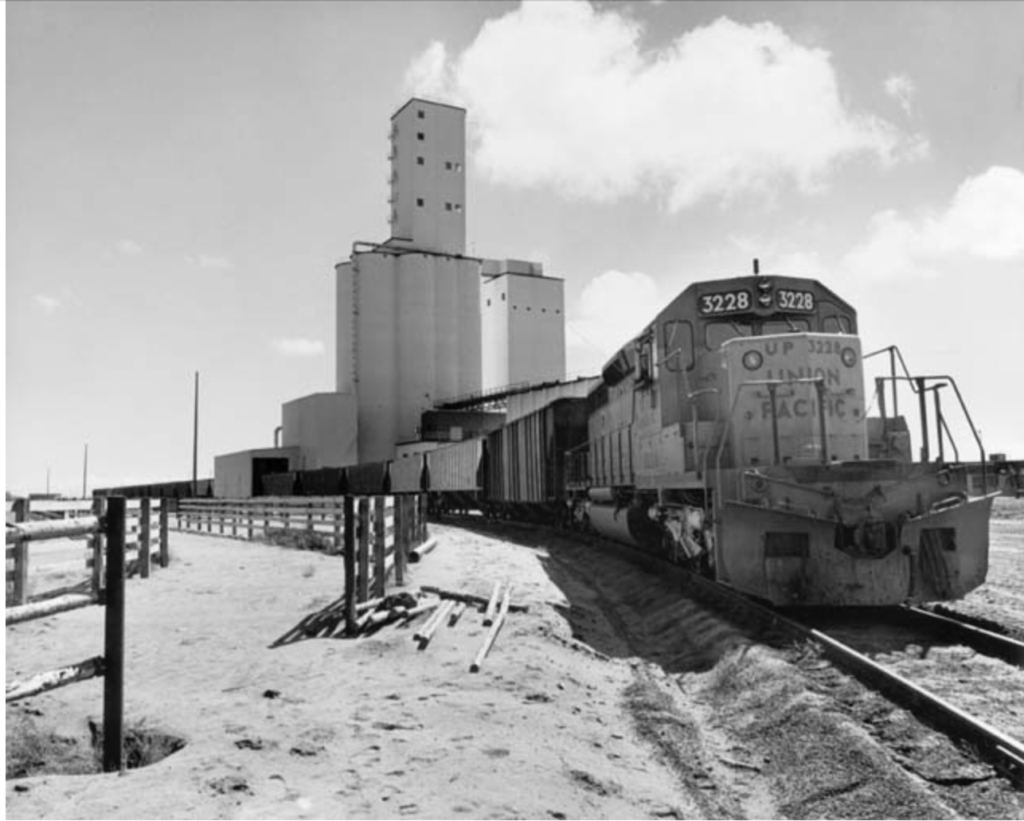
On September 26, 1941, at the age of 21, Lawrence Contreras enlisted in the U.S. Army. Private First Class Contreras was in the 165th Infantry Regiment, which dates back to World War I. Private First Class Conteras received training as an automatic rifleman, to provide suppressive firepower during battles. Contreras’ training in Alabama continued even as the nation faced the tragic days following the bombing of Pearl Harbor by the Japanese.
By April 8, 1942, Private First Class Contreras’ unit landed in Oahu, Hawaii. During this time, the United States sent a surplus of ships through the Atlantic to combat European forces but required reinforcement in the Pacific. The division began planning a counterattack on the Japanese as a response to the attack on Pearl Harbor, setting its sights on the Mariana Islands, east of the Philippines.
On November 20, 1943, the 165th Infantry Division, along with other divisions, waited along the shore of Makin Island for the perfect moment to execute their attack. Behind them was an even larger number of U.S. Marines, and many other military forces waited on coasts as far as Hawaii and New Zealand in the event of a disaster at Makin. This mission was planned around Contreras’ division, as they were to be the head of the attack. The 165th Infantry Regiment carried out its initial attack on the Coral Atoll of Makin, successfully defeating Japanese troops.
Private First Class Contreras returned to Hawaii with his division, soon departing for the island of Saipan. American soldiers landed on the western coast of Saipan as reinforcements for the Marine division on June 17, 1944, in an attempt to take the island from the Japanese. This mission, designed to disrupt Japanese supply lines, resulted in the successful capture of Aslito Airfield. However, as the 165th Infantry Regiment continued east through the mountainous terrain across Saipan, fatigue began to overtake many soldiers. Private First Class Contreras was shot and killed in the line of duty during this time of complete exhaustion, as he is accredited for taking the front lines to save the lives of his fellow soldiers.

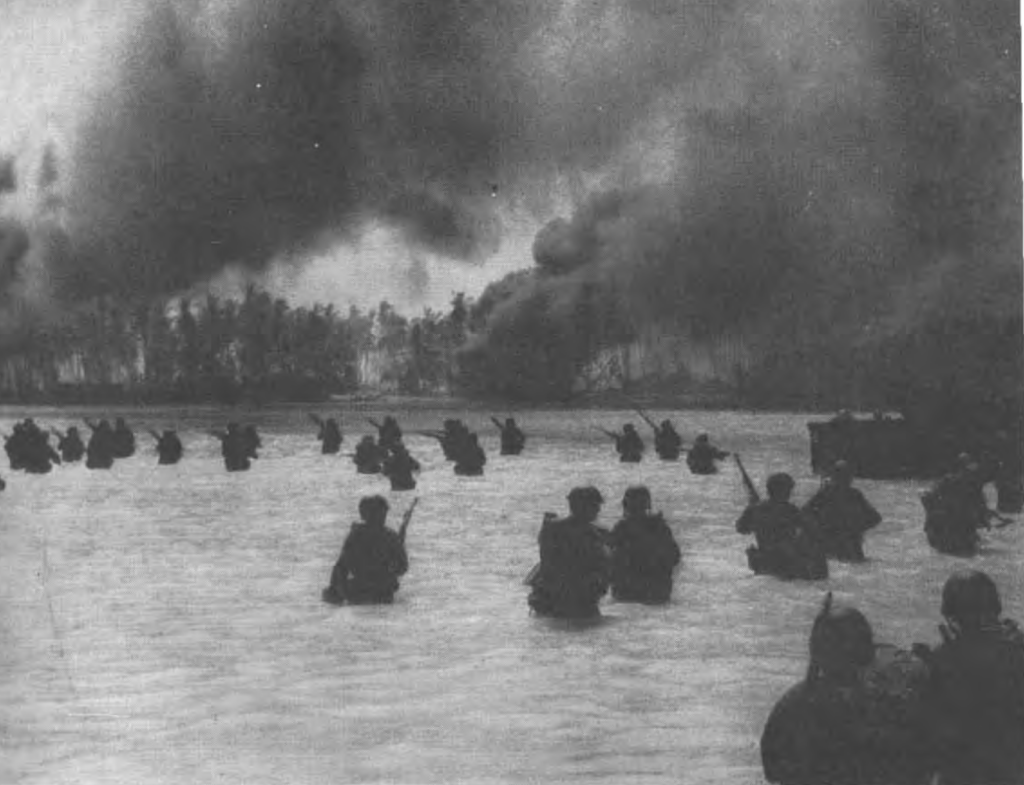

Private First Class Lawrence Contreras was born in Como, Wyoming, on January 29, 1919. Early in his childhood, his father moved the family to Greeley, Colorado, where they lived until Contreras enlisted in the United States Army on September 26, 1941, committing to our nation. Contreras joined the 165th Infantry Regiment, 27th Infantry Division. They prepared for the potential of American involvement in the war effort, as Japanese aggression increased across the Pacific, and World War II continued in Europe.
After the bombing of Pearl Harbor on December 7, 1941, the United States entered World War II. Private First Class Contreras completed his training as an automatic rifleman and was ready to serve the United States in the Pacific Theater.
After three weeks of battle in the unpredictable terrain of Saipan, many soldiers were tired as they faced continuous bombardment by Japanese troops. 13,000 soldiers were wounded, and 3,000 troops perished in the campaign. The American victory in Saipan was recognized on July 9, 1944. Lawrence Contreras never returned to the dusty farmlands in Greeley, Colorado. Private First Class Contreras was wounded on the front lines and died in the line of duty on July 11, 1944. Today we recognize Private First Class Lawrence Contreras of Colorado, a recipient of the Infantryman’s Badge, Bronze Star, and Purple Heart for his courage and commitment to our nation during World War II.
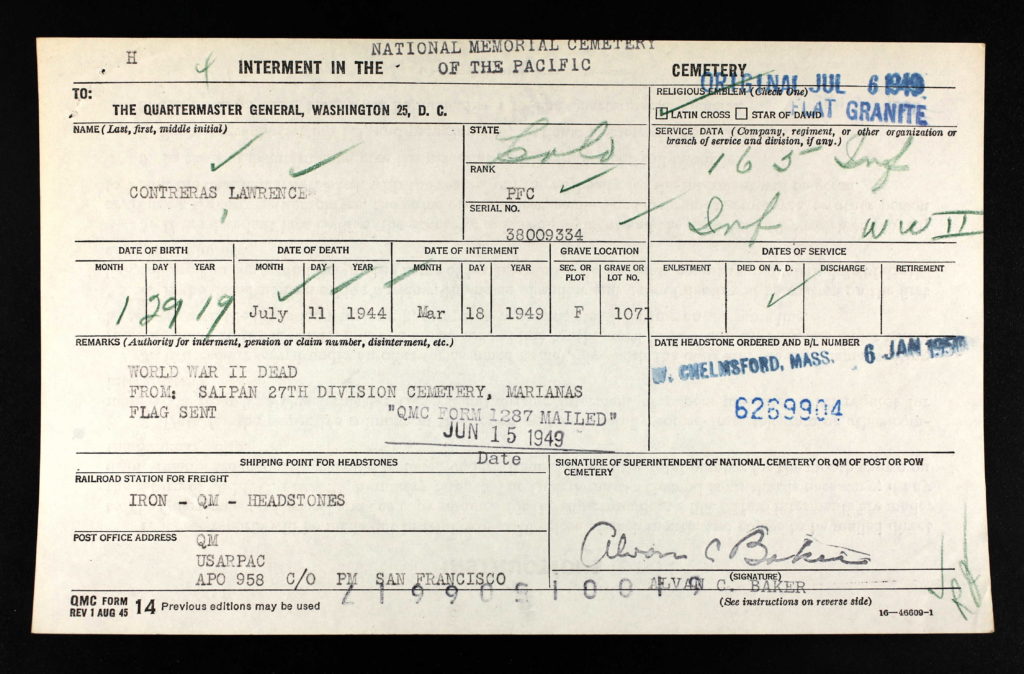
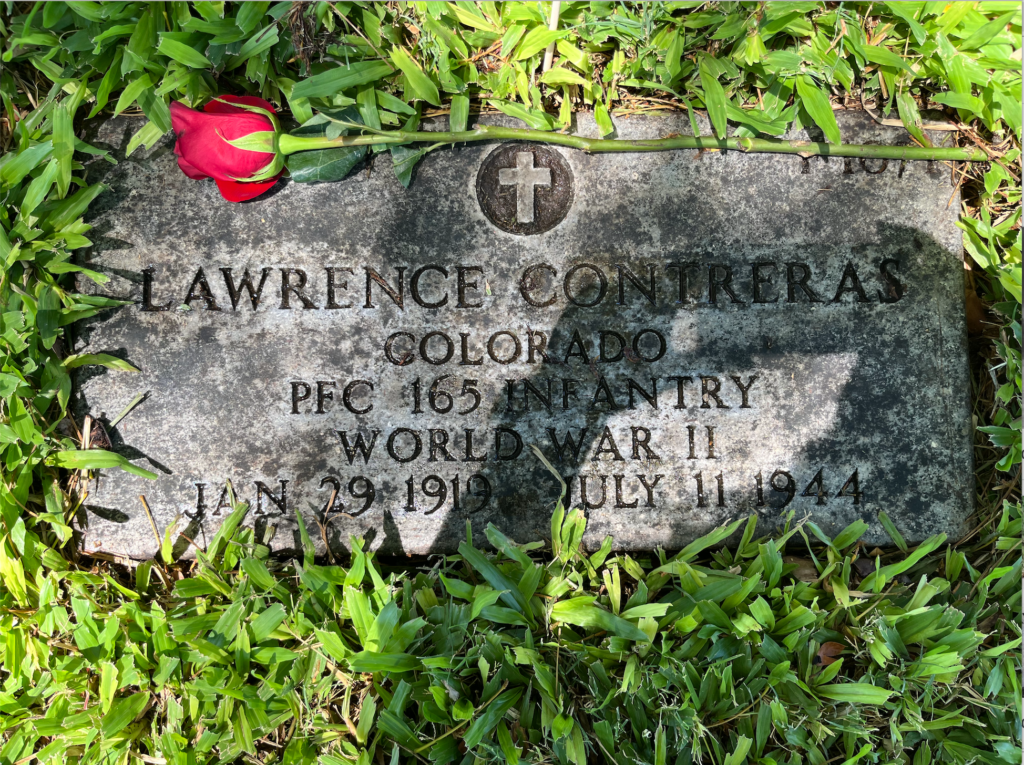
Primary Sources
Colorado. Denver County. 1940 U.S. Federal Census. Digital images. https://ancestry.com.
Contreras Family Photographs. 1941. Courtesy of the Contreras Family.
“Lawrence Contreras.” National Cemetery Administration. Accessed October 24, 2022. https://gravelocator.cem.va.gov/ngl/index.jsp.
Lawrence Contreras. World War II and Korean Conflict Veterans Interred Overseas. https://ancestry.com.
Lawrence Contreras. World War II Army Enlistment Records, 1938-1946. https://ancestry.com.
Lawrence Contreras. World War II Draft Cards Young Men, 1940-1947. Digital images. https://ancestry.com.
Lawrence Contreras. World War II Hospital Admission Card Files, 1942-1954. https://ancestry.com.
Lawrence Contreras. National Cemetery Interment Control Forms, 1928-1962. Digital images. https://ancestry.com.
Lawrence Quintana Contreras. Social Security Death Index, 1935-2014. https://ancestry.com.
“Posthumous Bronze Star Award to Local Soldier.” Contreras Family Records. https://www.familysearch.org/tree/person/memories/GWWP-582.
Sugar beet dump. Photograph. 1931. Denver Public Library Special Collections (X-8497). https://digital.denverlibrary.org/digital/collection/p15330coll22/id/6425/rec/6.
Monford Feedlots in the 1940s. Photograph. 1940s. Denver Public Library. https://www.greeleyhistory.org/pages/timeline.html.
Fort McClellan Alabama, 1941. Photograph. 1941. New York State Military Museum (PA.2001.1240). https://catalog.nysmm.org/Presto/content/Detail.aspx?ctID=ZDhjMmE5MjktYTE3Yi00M2Y0LWJmYjYtZDIxZWRlNmIxN2Vi&rID=MzM4&qrs=RmFsc2U=&q=UEEuMjAwMS4xMjQw&ph=VHJ1ZQ==&bckToL=VHJ1ZQ==&rrtc=VHJ1ZQ==.
Secondary Sources
“165th Infantry Regiment.” New York State Military Museum and Veterans Research Center. Accessed October 24, 2022. https://museum.dmna.ny.gov/unit-history/conflict/world-war-2-1939-1945/165th-infantry-regiment.
“Battle of Saipan.” HISTORY®. Updated August 21, 2018. Accessed October 24, 2022. www.history.com/topics/world-war-ii/battle-of-saipan.
Brooks, Sara L. “Greely History for Kids.” Accessed October 24, 2022. https://www.greeleyhistory.org/.
The Capture of Makin, 20-24 November 1943. Washington, D.C.: U.S. Army Center of Military History, 1990.
“History of Agriculture in Weld County.” History of Weld. Accessed October 24, 2022. https://history.weldgov.com/County-150/Agriculture/History-of-Agriculture-in-Weld-County.
Kroepsch, Adrianne. “Greeley.” Colorado Encyclopedia, History Colorado. Updated June 19, 2018. Accessed October 24, 2022. coloradoencyclopedia.org/article/greeley.
“PFC Lawrence Contreras.” Find a Grave. Accessed October 24, 2022. https://www.findagrave.com/memorial/104952606/lawrence-contreras.
“Pillars of P.O.W. Camp 202.” Colorado Preservation, Inc. Accessed October 24, 2022. coloradopreservation.org/programs/endangered-places/endangered-places-archives/pillars-of-p-o-w-camp-202/.
Scott, Steven L., Charles O. Collins, and David M. Diggs. Atlas of Colorado: A Teaching Resource. Colorado Geography Education Fund, 2004. Accessed October 24, 2022. https://www.unco.edu/hss/geography-gis-sustainability/pdf/atlas/atlas-full-reduced.pdf.
“Teaching Our Stories.” Boulder County Latino History. Accessed October 24, 2022. teachbocolatinohistory.colorado.edu/.
Whitlock, Flint. “Doing Our Part: Eleven Ways World War II Came to Colorado.” History Colorado. Updated December 4, 2020. Accessed October 24, 2022. www.historycolorado.org/story/2020/12/04/doing-our-part.
The American Battle Monuments Commission operates and maintains 26 cemeteries and 31 federal memorials, monuments and commemorative plaques in 17 countries throughout the world, including the United States.
Since March 4, 1923, the ABMC’s sacred mission remains to honor the service, achievements, and sacrifice of more than 200,000 U.S. service members buried and memorialized at our sites.